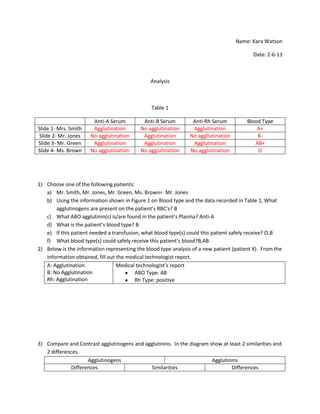
Blood typing analysis
- 1. Name: Kara Watson Date: 2-6-13 Analysis Table 1 Anti-A Serum Anti-B Serum Anti-Rh Serum Blood Type Slide 1- Mrs. Smith Agglutination No agglutination Agglutination A+ Slide 2- Mr. Jones No agglutination Agglutination No aggllutination B- Slide 3- Mr. Green Agglutination Agglutination Agglutination AB+ Slide 4- Ms. Brown No agglutination No agglutination No agglutination O 1) Choose one of the following patients: a) Mr. Smith, Mr. Jones, Mr. Green, Ms. Brown= Mr. Jones b) Using the information shown in Figure 1 on Blood type and the data recorded in Table 1, What agglutinogens are present on the patient’s RBC’s? B c) What ABO agglutinin(s) is/are found in the patient’s Plasma? Anti-A d) What is the patient’s blood type? B e) If this patient needed a transfusion, what blood type(s) could this patient safely receive? O,B f) What blood type(s) could safely receive this patient’s blood?B,AB 2) Below is the information representing the blood type analysis of a new patient (patient X). From the information obtained, fill out the medical technologist report. A: Agglutination Medical technologist’s report B: No Agglutination ABO Type: AB Rh: Agglutination Rh Type: positive 3) Compare and Contrast agglutinogens and agglutinins. In the diagram show at least 2 similarities and 2 differences. Agglutinogens Agglutinins Differences Similarities Differences
- 2. Found in erythrocytes, blood Both produced in blood, both Found in plasma, does not typing is based on part of the immune system contribute to blood typing agglutinogens 4) Pretend you went with your class on a medical career field trip to a local hospital. One of the stops on the visit was to the hospital’s blood lab. The medical technologist at this stop gave a demonstration of how blood types are determined. Your job is to write a paragraph for the school newspaper on the visit to the blood lab, summarizing what you’ve learned about how ABO/Rh blood groups are determined. Write a paragraph and include the title. How to determine blood types: The blood typing lab determines blood types by mixing different antogens with the blood. To determine the type the different antogens are added when they are mixed some will aggulate. If the different antogens cause aggulation then they result in determining the blood type, if aggulation is seen with anti- A serum and not with anti-B serum then the blood type is A. if there is no aggulation with the anti-A serum but there is with the Anti-B serum the blood type is B. if there is no aggulation with either serum, the blood type is O. if there is aggulation in both serums tthen the blood type is AB. If the anti-Rh serum aggulates the blood type is positive, if it does not the blood type is negative 5) List at least 3 situations where blood typing could be used. a) Blood Transfusions b) DNA tests c) Paternity tests 6) Define Erythroblastosis Fetalis. ErythroblastosisFetalis is a blood disease that occurs in fetuses or newborn babies and can be life threatening. It happens when the baby and mother have different blood types and are therefore incompatible. The mother produces antibodies and attack the baby’s blood cells. a) Describe the sequence of events that lead to this condition. This happens when a woman with Rh- positive blood conceives a baby with Rh- positive blood. Their blood types are incompatible, causing anemia in the baby. b) What might be some benefits if the medical profession developed a shot or vaccination that could desensitize an Rh+ situation?The babies and fetuses would be protected against this disease and lives would be saved. 7) You are a type A eryhthorocyte placing an ad in the personals and you are seeking a compatible mate for a long lasting transfusion. Create an ad to be submitted to the newspaper. TYPE A ERYHTHOROCYTE SEEKING COMPATIBLE BLOOD DONOR FOR LONG TERM TRANSFUSION Please contact ASAP: 555-555-5555 8) Another important diagnostic tool used by medical technologist is determining a patient’s blood cell count, for both red blood cells and white blood cells. When this procedure is performed, one technique used is to take multiple samples and calculate the average. This method of multiple sampling is a standard procedure in scientific and medical investigations. Discuss why this method is
- 3. important in blood typing. It is important to take multiple samples so you get a nice variety of the blood type. Also 9) Each year thousands of people contract blood borne diseases. What could be done in a clinical blood lab to minimize the risk of obtaining or spreading a blood borne disease?Wash their hands and clean their instruments thoroughly. Wear personal protection equipment etc. 10) In a short paragraph, identify what you think may be the next important breakthrough, milestone or discovery in the study of blood and blood diseases and explain why. Man made blood.